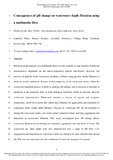JavaScript is disabled for your browser. Some features of this site may not work without it.
| dc.contributor.author | Ncube, Philani | |
| dc.contributor.author | Pidou, Marc | |
| dc.contributor.author | Stephenson, Tom | |
| dc.contributor.author | Jefferson, Bruce | |
| dc.contributor.author | Jarvis, Peter | |
| dc.date.accessioned | 2017-12-18T14:48:06Z | |
| dc.date.available | 2017-12-18T14:48:06Z | |
| dc.date.issued | 2017-10-21 | |
| dc.identifier.citation | Philani Ncube, Marc Pidou, Tom Stephenson, Bruce Jefferson, Peter Jarvis, Consequences of pH change on wastewater depth filtration using a multimedia filter. Water Research, Volume 128, 2018, Pages 111-119 | en_UK |
| dc.identifier.issn | 0043-1354 | |
| dc.identifier.uri | https://doi.org/10.1016/j.watres.2017.10.040 | |
| dc.identifier.uri | http://dspace.lib.cranfield.ac.uk/handle/1826/12778 | |
| dc.description.abstract | Different media materials in a multimedia filter have the potential to trap particles of different characteristics dependent on the media-suspension particle interactions. However, the removal of particles from wastewater secondary effluent using granular media filtration is relatively poorly understood because of the complexity of the wastewater matrix. Often the wastewater treatment process is liable to undergo pH changes due to removal or addition of chemicals in the treatment chain or from biological instability which in turn may alter the wastewater characteristics. Wastewater contains a mixture of organic and inorganic components, dissolved or particulate which may influence the aggregation and deposition of suspension solids during depth filtration. Changes in wastewater pH has the potential to change the wastewater matrix and media surface properties hence affecting aggregation and deposition in wastewater filtration. This study investigated how pH change affects wastewater filtration by monitoring zeta potential, aggregation and deposition of solids. The wastewater and filter media were also characterised over a range of pH from 1 to 13. Aggregation and deposition of wastewater solids was found to be most efficient near neutral pH. This was not concurrent with the conditions of lowest net charge in the system. | en_UK |
| dc.language.iso | en | en_UK |
| dc.publisher | Elsevier | en_UK |
| dc.rights | Attribution-NonCommercial-NoDerivatives 4.0 International | * |
| dc.rights.uri | http://creativecommons.org/licenses/by-nc-nd/4.0/ | * |
| dc.subject | Multimedia | en_UK |
| dc.subject | Depth filtration | en_UK |
| dc.subject | Surface charge | en_UK |
| dc.subject | Zeta potential | en_UK |
| dc.subject | Aggregation | en_UK |
| dc.subject | Deposition | en_UK |
| dc.title | Consequences of pH change on wastewater depth filtration using a multimedia filter | en_UK |
| dc.type | Article | en_UK |
| dc.identifier.cris | 18898456 |
Files in this item
The following license files are associated with this item:
This item appears in the following Collection(s)
-
Staff publications (SWEE) [2815]

